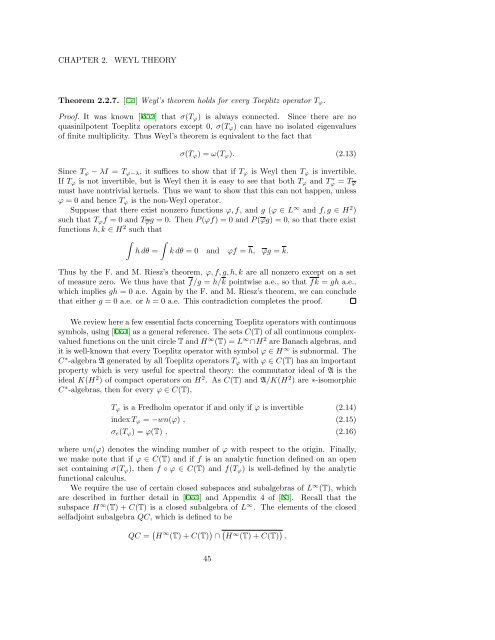Woo Young Lee Lecture Notes on Operator Theory
Woo Young Lee Lecture Notes on Operator Theory
Woo Young Lee Lecture Notes on Operator Theory
Create successful ePaper yourself
Turn your PDF publications into a flip-book with our unique Google optimized e-Paper software.
CHAPTER 2.<br />
WEYL THEORY<br />
Theorem 2.2.7. [Co] Weyl’s theorem holds for every Toeplitz operator T φ .<br />
Proof. It was known [Wi2] that σ(T φ ) is always c<strong>on</strong>nected. Since there are no<br />
quasinilpotent Toeplitz operators except 0, σ(T φ ) can have no isolated eigenvalues<br />
of finite multiplicity. Thus Weyl’s theorem is equivalent to the fact that<br />
σ(T φ ) = ω(T φ ). (2.13)<br />
Since T φ − λI = T φ−λ , it suffices to show that if T φ is Weyl then T φ is invertible.<br />
If T φ is not invertible, but is Weyl then it is easy to see that both T φ and Tφ ∗ = T φ<br />
must have n<strong>on</strong>trivial kernels. Thus we want to show that this can not happen, unless<br />
φ = 0 and hence T φ is the n<strong>on</strong>-Weyl operator.<br />
Suppose that there exist n<strong>on</strong>zero functi<strong>on</strong>s φ, f, and g (φ ∈ L ∞ and f, g ∈ H 2 )<br />
such that T φ f = 0 and T φ g = 0. Then P (φf) = 0 and P (φg) = 0, so that there exist<br />
functi<strong>on</strong>s h, k ∈ H 2 such that<br />
∫ ∫<br />
h dθ = k dθ = 0 and φf = h, φg = k.<br />
Thus by the F. and M. Riesz’s theorem, φ, f, g, h, k are all n<strong>on</strong>zero except <strong>on</strong> a set<br />
of measure zero. We thus have that f/g = h/k pointwise a.e., so that fk = gh a.e.,<br />
which implies gh = 0 a.e. Again by the F. and M. Riesz’s theorem, we can c<strong>on</strong>clude<br />
that either g = 0 a.e. or h = 0 a.e. This c<strong>on</strong>tradicti<strong>on</strong> completes the proof.<br />
We review here a few essential facts c<strong>on</strong>cerning Toeplitz operators with c<strong>on</strong>tinuous<br />
symbols, using [Do1] as a general reference. The sets C(T) of all c<strong>on</strong>tinuous complexvalued<br />
functi<strong>on</strong>s <strong>on</strong> the unit circle T and H ∞ (T) = L ∞ ∩H 2 are Banach algebras, and<br />
it is well-known that every Toeplitz operator with symbol φ ∈ H ∞ is subnormal. The<br />
C ∗ -algebra A generated by all Toeplitz operators T φ with φ ∈ C(T) has an important<br />
property which is very useful for spectral theory: the commutator ideal of A is the<br />
ideal K(H 2 ) of compact operators <strong>on</strong> H 2 . As C(T) and A/K(H 2 ) are ∗-isomorphic<br />
C ∗ -algebras, then for every φ ∈ C(T),<br />
T φ is a Fredholm operator if and <strong>on</strong>ly if φ is invertible (2.14)<br />
index T φ = −wn(φ) , (2.15)<br />
σ e (T φ ) = φ(T) , (2.16)<br />
where wn(φ) denotes the winding number of φ with respect to the origin. Finally,<br />
we make note that if φ ∈ C(T) and if f is an analytic functi<strong>on</strong> defined <strong>on</strong> an open<br />
set c<strong>on</strong>taining σ(T φ ), then f ◦ φ ∈ C(T) and f(T φ ) is well-defined by the analytic<br />
functi<strong>on</strong>al calculus.<br />
We require the use of certain closed subspaces and subalgebras of L ∞ (T), which<br />
are described in further detail in [Do2] and Appendix 4 of [Ni]. Recall that the<br />
subspace H ∞ (T) + C(T) is a closed subalgebra of L ∞ . The elements of the closed<br />
selfadjoint subalgebra QC, which is defined to be<br />
QC = ( H ∞ (T) + C(T) ) ∩ ( H ∞ (T) + C(T) ) ,<br />
45













